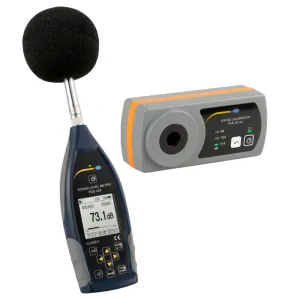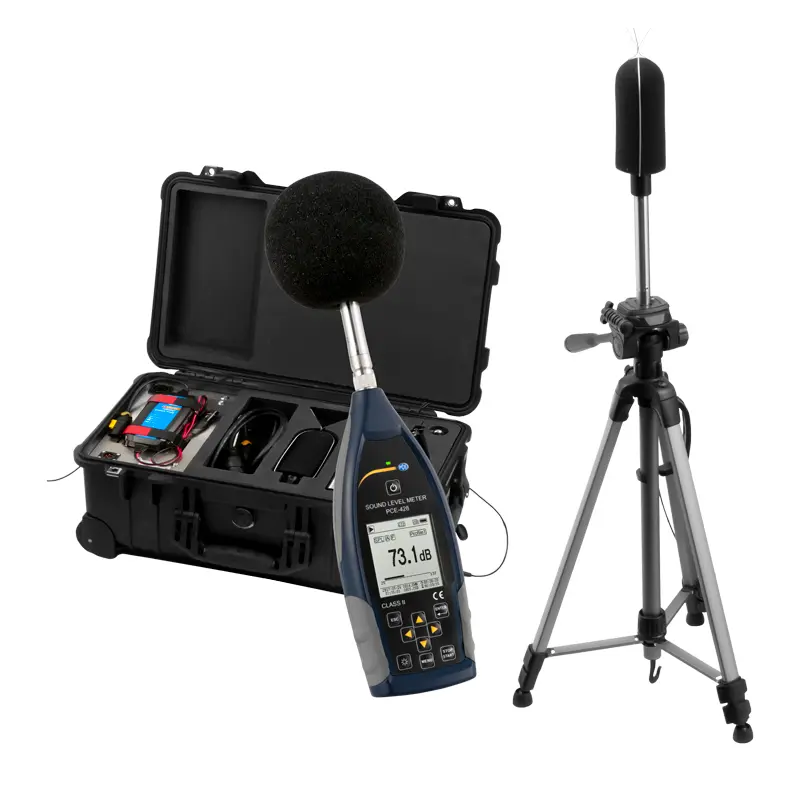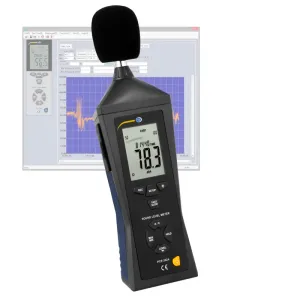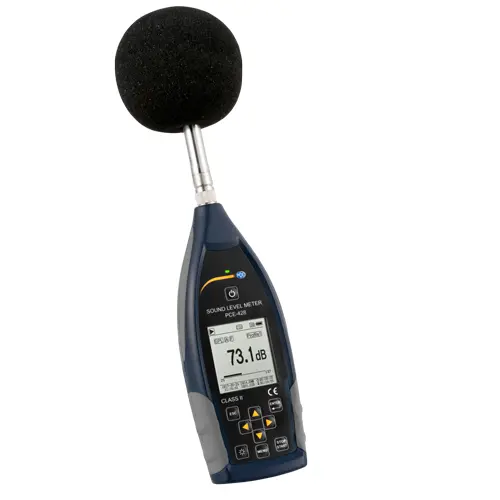Sound Level Meter / Noise Level Meter
What is a Sound Level Meter / Noise Level Meter?
A sound level meter / noise level meter measures the intensity of sound in decibels (dB). It is a handy tool for assessing noise levels in various environments, from industrial settings to public spaces. It gauges how loud things are, helping to monitor and control sound for safety and comfort. Often referred to as a sound pressure level (SPL) meter, decibel (dB) meter, noise meter, or noise dosimeter, a sound level meter uses a microphone to capture sound.
Sound level meter / noise level meter consists of a microphone, an amplifier, and a display unit. The microphone captures the sound, and the amplifier converts the electrical signal into a readable sound level value. Industries widely use sound level meters in various applications, including environmental monitoring, occupational safety, and noise control, to assess and manage sound levels in different settings.
Highlight
Introducing the Data Logging Sound Level Meter: The Ideal Solution for Workplace, Construction Site, Traffic and Airport Sound Measurements. Our sound level meter is a top-quality instrument suitable for various applications. Its class 2 rating and octave band frequency filter make it a top-performing device. In addition, the meter can be upgraded to include a 1/3 octave band filter for even greater precision. Here are some key features:
- Accuracy class 2
- A, B, C & Z frequency weighting
- Fast, Slow, Impulse and Peak time weighting
- Statistics function
- 1/1 octave band included
- 1/3 octave band optional
- Includes class II sound calibrator
Highlight
The PCE-322ALEQ sound level meter / noise level meter is an ideal solution for measuring noise levels in various fields such as industrial, health, safety, and environmental monitoring. The device is equipped with a logger function capable of storing up to 32700 readings.
Specifications:
- Automatic range: 30 – 130 dB
- Manual range: 30 … 80 / 50 … 100 / 80 … 130 dB
- Resolution: 0.1 dB
- Accuracy: ±1.4 dB
- Memory capacity: 32700 values
- Includes software for LEQ calculation
Please note that the software is required to calculate the LEQ value, which can only be done after transferring the data from the device to a PC or laptop.
Highlight
The PCE-428-EKIT is a highly effective sound level meter designed for use in various locations, including construction sites, traffic areas, and airports, among others. This outdoor sound level meter comes with an octave band frequency filter, while a 1/3 octave band filter is available as an optional upgrade. The PCE-428-EKIT boasts the following features:
- Class 2 accuracy
- A, B, C, and Z frequency rating
- Fast, Slow, Pulse, and Peak time weighting
- Statistics function
- 1/1 octave band included
- 1/3 octave band optional
- Comes with an outdoor noise level meter kit PCE-4xx-EKIT
- Enables outdoor measurement of sound and noise, even in wet conditions
Highlight
The PCE-322A is a top-of-the-line sound level meter that is both portable and handheld. Its sophisticated built-in data logging system allows for real-time noise measurement and long-term monitoring. The device is also equipped with a memory that can store up to 32,700 readings. Here are some of the key features of the PCE-322A:
Class 2
Sound measuring range: 30 …130 dB
Resolution: 0.1 dB
Accuracy: ±1.4 dB
Time weighting: A, C
Frequency weighting: Slow, fast
Sampling rate: 2 times per second
ISO calibration is available as an option.
Highlight
The PCE-428 is a portable, Class 2 sound level meter that adheres to numerous requirements, including IEC 60651:1979, IEC 60804:2000, IEC 61672-1:2013, ANSI S1.4-1983, and ANSI S1.43-1997. Its large, illuminated LCD screen displays real-time sound pressure levels (SPL) both numerically and graphically. This device also calculates the equivalent continuous sound level Leq (LXeq) for unparalleled accuracy.
- Measuring range: 25 … 136 db(A)
- LXY (SPL), Leq (LXeq), LXYSD, LXSEL, LXE, LXYmax, LXYmin, LXPeak, LXN
- Frequency weighting: A, B, C and Z
- Time weighting: Fast (125 ms), slow (1 sec) and impulse (35 ms), decay (1500 ms)
- Adjustable data-recording interval from 1 s … 24 h
- 1/1 octave band filter (optional 1/3 octave band filter upgrade)
Tips on Purchasing a Sound Level Meter for Accurate Noise Measurement
Introduction:
When it comes to measuring and monitoring sound, a reliable Sound Level Meter (also known as a Noise Level Meter or dB Meter) is an indispensable tool. Understanding the key factors and features of these devices is crucial for making an informed purchase. In this guide, we’ll provide valuable tips on buying a Sound Level Meter, shedding light on its working principle, uses, and units of measurement.
1. Understanding Sound Level Meter Basics:
Before diving into the purchase process, grasp the fundamental concept of a Sound Level Meter. It is an electronic device designed to measure the intensity of sound in decibels (dB), providing an accurate representation of noise levels in various environments.
2. Working Principle of Sound Level Meters:
Familiarize yourself with the working principle of Sound Level Meters. These devices typically use a microphone to convert acoustic signals into electrical signals. The signals are then processed to determine the sound pressure level, offering a quantitative measure of the intensity of sound.
3. Consider the Application:
Assess your specific needs and the intended application of the Sound Level Meter. Different models are tailored for various environments such as industrial settings, construction sites, or residential areas. Choose a device that aligns with the noise monitoring requirements of your particular use case.
4. Accuracy and Calibration:
Prioritize accuracy when selecting a Sound Level Meter. Look for devices with precise calibration capabilities to ensure reliable and consistent measurements. Regular calibration is essential to maintain accuracy over time, so consider models with straightforward calibration processes.
5. Range and Frequency Weighting:
Pay attention to the measurement range and frequency weighting options offered by the Sound Level Meter. A broad measurement range accommodates different noise levels, while frequency weighting options (A, B, or C) allow customization based on the frequency characteristics of the sound being measured.
6. Ease of Use and Portability:

Opt for a user-friendly Sound Level Meter with an intuitive interface. Portability is also a key consideration, especially if you need to conduct measurements in various locations. Compact and lightweight models with easy-to-navigate menus facilitate convenient usage.
7. Battery Life and Power Options:
Evaluate the battery life of the Sound Level Meter, especially if prolonged usage is anticipated. Additionally, consider the power options available, such as rechargeable batteries or USB power sources, to ensure consistent performance during measurements.
8. Data Logging and Connectivity:
For advanced monitoring and analysis, choose a Sound Level Meter with data logging capabilities. Models that offer connectivity options, such as USB or Bluetooth, allow seamless transfer of data to external devices for in-depth analysis and reporting.
Conclusion:
Investing in a quality Sound Level Meter is crucial for accurate noise measurement and environmental monitoring. By considering factors such as working principle, application-specific needs, accuracy, and additional features, you can make an informed decision that aligns with your requirements. Stay attuned to the latest advancements in sound measurement technology to ensure your purchase meets both current and future demands.






